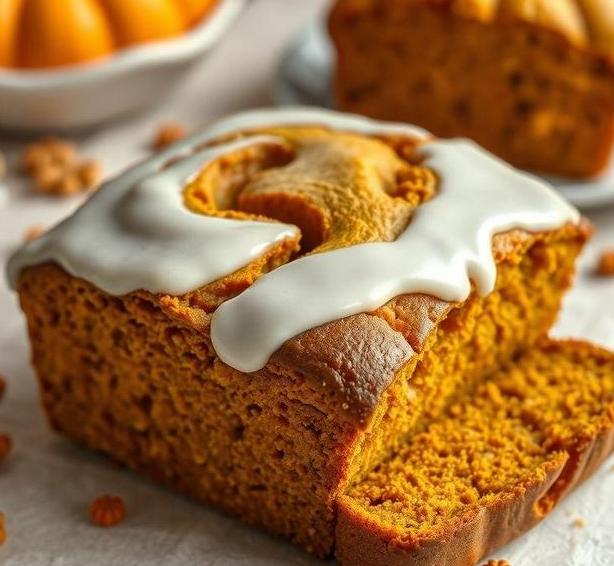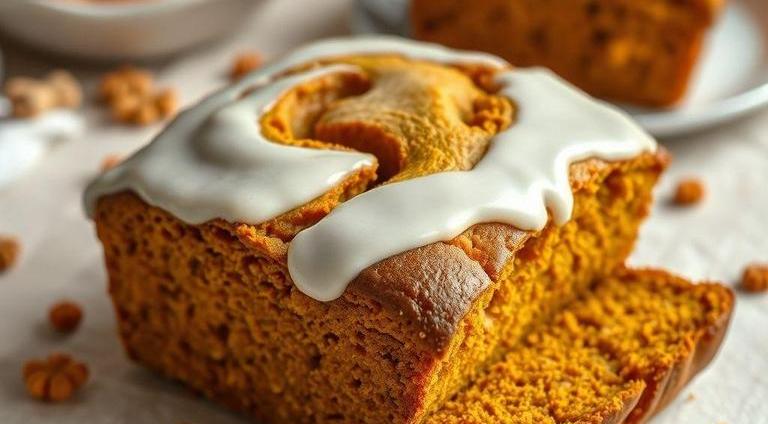Pumpkin bread is one of those cozy, comfort foods that bring the essence of autumn right to your kitchen. Whether it’s a treat for the holiday season or just a simple indulgence on a chilly day, there’s something about its moist texture, sweet and spicy flavor, and warm aroma that just makes it irresistible. But like all baked goods, pumpkin bread doesn’t last forever, and sometimes we’re left wondering, “Can pumpkin bread go bad”? and “How do I make sure my beloved loaf stays fresh as long as possible”?
In this guide, we’ll answer those questions in-depth and give you all the tips and tricks for storing pumpkin bread properly to ensure it lasts and remains delicious. We’ll also cover the key signs that your pumpkin bread may have spoiled, how to tell if it’s still good to eat, and give you expert advice to make sure your loaves stay in tip-top shape. So, whether you’re planning to bake a batch of pumpkin bread for yourself or gift it to someone special, stick around for everything you need to know.
Can Pumpkin Bread Go Bad?
Yes, pumpkin bread can absolutely go bad. Despite its moist texture, which can sometimes feel like it keeps everything soft and fresh, it’s still a perishable food item. While the bread itself is made with ingredients that can stay good for a period of time (like sugar, flour, and pumpkin puree), once it’s baked, the combination of moisture and the natural sugars in the bread make it a potential breeding ground for bacteria and mold, particularly if it’s not stored properly.
- Why it can spoil: The bread’s high moisture content (from ingredients like pumpkin and oil) and the warmth from being freshly baked create an environment that, if left unattended, can quickly encourage mold growth or spoilage.
- Shelf life factors: The exact shelf life of your pumpkin bread will vary depending on how it’s stored, but just like most baked goods, it has a limited window of freshness before it starts to decline in quality.
So, the short answer is: Yes, it can go bad. But the good news is there are ways to extend its shelf life and keep it fresh for longer. Let’s dive into that next.
Shelf Life For Pumpkin Bread

The shelf life of pumpkin bread varies based on a few key factors like whether it’s homemade or store-bought, and how it’s stored. But in general, pumpkin bread is best enjoyed within a specific timeframe for optimal taste and texture.
Here’s a breakdown:
-
Room Temperature
- If stored properly (in an airtight container or wrapped tightly), homemade pumpkin bread can last for about 3-4 days at room temperature.
- Keep it in a cool, dry place away from direct sunlight. Don’t leave it on the counter uncovered, as this can lead to it drying out or becoming stale quickly.
-
Refrigeration
- Refrigerating your pumpkin bread can extend its shelf life a bit longer, up to about 1 week. The cool temperature slows down the growth of bacteria and mold, but it may slightly affect the bread’s texture, making it denser and drier.
-
Freezing
- For the longest shelf life, freezing is the way to go. If you freeze your pumpkin bread, it can last up to 3 months (or even longer in some cases). Just be sure to wrap it tightly in plastic wrap, followed by foil or an airtight container, to prevent freezer burn.
Common Signs Of Spoilage
Even if you’re following the right storage guidelines, pumpkin bread can still go bad. Here are a few key signs to look out for that indicate your pumpkin bread has spoiled:
-
Mold
- This is the most obvious sign of spoilage. If you see any mold growing on the bread-whether it’s a white, green, or blue fuzzy coating-toss it. Mold spores can grow quickly in moist environments like pumpkin bread, and moldy bread can make you sick.
-
Off Or Sour Smell
- Fresh pumpkin bread has a pleasant, sweet, and spicy aroma. If it starts to smell sour, rancid, or “off”, it’s time to say goodbye. This could be due to the bread’s ingredients, like the oil or pumpkin, going bad.
-
Changes In Texture
- While pumpkin bread is naturally moist, if it becomes excessively soggy, or if it dries out completely (especially if it feels hard and crumbly), it’s no longer at its best. A drastic change in texture is usually a red flag.
-
Discoloration
- Another potential sign is if the bread starts changing color-whether it’s a dull, grayish hue or the top starts to look too dark. This might not always indicate that the bread is unsafe to eat, but it could mean it’s past its prime.
-
Odd Taste
- If the bread tastes off, bitter, or strange in any way, it’s not worth risking. Trust your taste buds-if it doesn’t taste like it should, don’t continue eating it.
How To Store Pumpkin Bread?

Proper storage is key to extending the shelf life of your pumpkin bread and ensuring it stays fresh and delicious for as long as possible. Here are a few tips for the best way to store your loaf:
-
For Short-Term Storage (3-4 Days)
- Wrap it well: Once your pumpkin bread has cooled completely, wrap it tightly in plastic wrap or wax paper. If you have a large loaf, you can also wrap it in aluminum foil.
- Use an airtight container: Place the wrapped bread in an airtight container or a resealable plastic bag. This helps to lock in moisture and prevent the bread from drying out.
- Keep it at room temperature: Store the bread in a cool, dry place like your kitchen counter. Avoid storing it near heat sources, which can accelerate spoilage.
-
For Longer-Term Storage (Up To A Week)
- Refrigerate: Store your wrapped bread in the fridge to extend its shelf life. Although refrigeration can dry out the bread, it will prevent mold growth and keep it safe to eat for a longer period.
-
For Maximum Freshness (Up To 3 Months)
- Freeze it: If you won’t finish your pumpkin bread within a few days, freezing is the best option. To freeze, wrap the bread tightly in plastic wrap or parchment paper, followed by aluminum foil. You can also place it in a freezer-safe bag to prevent freezer burn.
- Slice before freezing: If you want to thaw just a slice at a time, slice the bread before freezing. This makes it easier to take out individual portions without defrosting the whole loaf.
Expert Tips
If you want to make sure your pumpkin bread stays as fresh as possible, here are some expert tips to follow:
- Let it cool completely before wrapping: To avoid trapping moisture inside and causing mold growth, always make sure the bread is fully cooled before you wrap it up.
- Avoid cutting into the loaf until you’re ready to eat: Slicing the bread exposes more surface area to air, which can dry it out faster. Wait to slice it until you’re ready to serve.
- Add a slice of bread or apple to keep it moist: Some bakers recommend placing a slice of bread or an apple wedge in the storage container to help keep the pumpkin bread moist, especially if you’re storing it for a few days. Just be sure to replace the apple if it starts to shrivel.
- Consider using a parchment paper liner when baking: If you bake your pumpkin bread in a pan lined with parchment paper, it can help with the cooling process and prevent the bread from sticking or losing too much moisture during storage.
FAQs
Can Pumpkin Bread Go Bad If Left Out Overnight?
Yes, pumpkin bread can go bad if left out overnight, especially if it contains perishable ingredients like cream cheese or butter. It is best to store it in an airtight container at room temperature for 2-3 days or refrigerate it to extend its shelf life.
How Long Does Pumpkin Bread Last At Room Temperature?
At room temperature, homemade pumpkin bread typically lasts about 2-3 days if properly stored in an airtight container. However, its quality may decline after this period, and it can begin to dry out or grow mold.
Can You Freeze Pumpkin Bread?
Yes, pumpkin bread freezes very well. If you want to store it for longer than a few days, wrap it tightly in plastic wrap or foil and place it in a freezer-safe bag. It can last up to 3 months in the freezer.
How Can I Tell If Pumpkin Bread Has Gone Bad?
Signs that pumpkin bread has gone bad include mold growth, an off or sour smell, or a dry and crumbly texture. If the bread has become discolored or shows signs of fermentation, it’s best to discard it.
Can Pumpkin Bread Go Bad In The Refrigerator?
Pumpkin bread can last longer in the refrigerator, typically 1-2 weeks, due to the lower temperature slowing the growth of mold and bacteria. Be sure to store it in an airtight container to prevent it from drying out.
Is It Safe To Eat Pumpkin Bread After The Expiration Date?
It is not recommended to eat pumpkin bread after its expiration date, especially if it shows signs of spoilage. The expiration date typically refers to the period in which the bread is at its best quality, and consuming it afterward could increase the risk of foodborne illness.
Can Pumpkin Bread Spoil Due To Humidity?
Yes, high humidity can cause pumpkin bread to spoil more quickly. Moisture encourages the growth of mold and bacteria, so it’s important to store pumpkin bread in a dry, cool environment, preferably in an airtight container.
What Is The Best Way To Store Pumpkin Bread?
To store pumpkin bread, keep it in an airtight container at room temperature for up to 2-3 days. If you plan to keep it for a longer period, refrigerate it or freeze it. Freezing is particularly effective for preserving its quality.
Can Pumpkin Bread Go Bad If It Contains Nuts Or Seeds?
Yes, pumpkin bread containing nuts or seeds can go bad faster because the oils in the nuts can become rancid over time. It’s important to store it properly in an airtight container to help maintain freshness.
Can Pumpkin Bread Go Bad In A Sealed Plastic Bag?
While a sealed plastic bag can help keep pumpkin bread fresh, it is not as effective as using an airtight container for long-term storage. Plastic bags can trap moisture, which may lead to mold growth or sogginess if left too long.